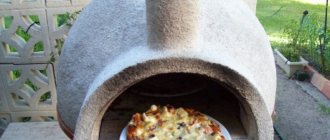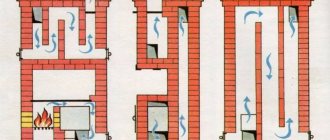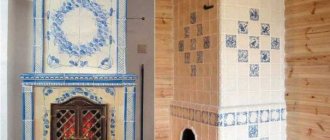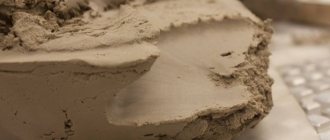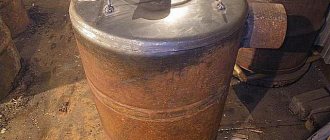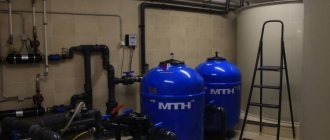Today you can count more than a dozen different types and designs of stone ovens for cooking, but the Pompeian oven occupies a special place among them.
Pompeii oven
Compact, efficient and beautiful - it will not only allow you to cook delicious food, but will also look stylish on any country plot. How to lay out a Pompeian oven with your own hands, and what technical nuances should be taken into account, we will discuss in this article.
A standard Pompeii stove is characterized by certain proportions that must be observed regardless of the shape and size of the structure. Thus, the height of the entrance is approximately equal to 50% of the total height of the dome. This allows you to optimize the work process as much as possible, create normal traction and reduce heat losses.
Design Features
Thanks to the special internal structure of the oven, it heats up quickly and retains heat for a long time. Historians claim that the Pompeian oven appeared on the Iberian Peninsula and was initially used specifically for preparing an open cheese pie, where the structure was not needed to heat the room.
Decoration of a Pompeii oven
Later it spread throughout the world. It is also called Neapolitan, Italian oven, tandoor.
The Pompeian oven will not only be an ideal design for preparing pizza, pies and bread, but will also decorate any countryside area. In combination with a gazebo or barbecue, it becomes a real landscape decoration, becoming a favorite vacation spot for the whole family.
Stove in the yard
Basically, such a stove is installed in suburban areas on the street, in a barbecue area, in an outdoor garden, but if desired and some technical modifications are made, a Pompeii stove can be built in the house. To do this, of course, you will have to provide not only a reliable, solid foundation, but also a chimney.
In this article we will look at the classic option for building an Italian oven in the open air. Before proceeding with the step-by-step instructions, I would like to warn you that laying a Pompeian stove is a very difficult and expensive undertaking.
But if you do everything correctly, then such an oven will delight you for decades, giving you an authentic look to your dacha and helping you prepare delicious homemade baked goods. Thanks to our clear and simple instructions, even a beginner can master the laying of a Pompeian stove with his own hands.
The structure of the Pompeian stove is somewhat similar to the design of the ancient Slavic stove.
Construction of a Pompeii furnace
But, unlike a traditional Russian stove, it heats up much faster. You can cook pies in it literally 30 minutes after heating, while a Russian oven will take at least 3-4 hours before reaching the optimal temperature for cooking.
This heating rate in the Pompeii furnace is achieved due to the lower thermal mass. The layer of brick that is heated is only 12 cm. Within 45 minutes after kindling, the temperature in this oven reaches 260 degrees, and after an hour - 370 degrees.
How is the temperature distributed in a Pompeian oven?
| In 30 minutes | In 45 minutes | In 60 minutes | In 90 minutes | |
| Outer part of the vault | 150 | 260 | 370 | 370 |
| Inner part of the vault | 315 | 370 | 370 | 370 |
The peculiarity and main advantage of the Pompeian oven is that you can cook almost any dish in it in a short time. Thanks to the high temperature that is reached inside the vault, pizza and bread are perfectly baked in it. Smoke adds a special piquancy to baked goods.
Construction costs
For the planned construction of a pompeii in any form or composition, costs will vary depending on the source materials and the size of the furnace body. On a small budget, you need to look for free or improvised materials to build your stove. These can be any bricks that are left over from the construction site and the house. Costs are likely to increase when choosing quality bricks to build a large oven, along with load-bearing structures and coverings and stylish cladding. Hiring a contractor for the raw materials to build the stove will be more expensive. If one is looking to reduce the burden of selecting the materials needed to build a fireplace, purchasing a pre-fabricated, partially formed kit is an option.
Operating principle of the Pompeii furnace
The efficiency of the Italian pizza oven is due to the technical design features.
Principle of operation
When solid fuel burns, two streams of hot gases arise inside the dome:
- Convection flow that comes from the firebox itself.
- The reflected flow comes from the walls of the dome.
It is also noteworthy that the temperature in the Pompeii oven is self-regulating.
Movement of cold and hot flows
The hotter the wood burns in the stove, the greater the amount of gases released. Rushing upward in a powerful stream, they block the flow of oxygen in the section of the pipe mouth. Consequently, the intensity of combustion decreases, and hence the temperature decreases.
When the temperature drops, the flow of hot gases also weakens, again opening up access to oxygen.
This cyclical process helps regulate the optimal temperature in the oven necessary for cooking bread, pies, pizza and any other food.
As can be seen from the figure, it is the dome that is the main element of the furnace, accumulating thermal energy from the fire.
Having analyzed the operating principle and design of the furnace, we can summarize and highlight the main pros and cons of the Pompeii furnace design.
Benefits include:
- Fast heating. Already 30 minutes after kindling, raw food can be loaded into such an oven for cooking. While the heating time of a classic Russian stove is at least 2 hours.
- Good heat dissipation. Even after the wood has burned, the heat in the Pompeii stove continues to be maintained for several hours, allowing food to be “stewed.”
- The compact dimensions of the unit allow the stove to fit seamlessly into almost any summer cottage.
- Stylish appearance.
Stylish appearance
The disadvantages of the Pompeian stove include:
- Complexity of design. Unlike the traditional laying of a brick stove for a summer residence, skill will be required here to correctly lay out the dome, which is an integral attribute of the unit.
- High cost of materials.
- The need to build a strong foundation, since the stove is not light in weight.
Gas, electricity or wood?
Some experts say that only a wood-fired pizza oven produces the real product, and this is true. The design of a wood-burning pizza oven is such (see below) that the combustion of fuel in it is rather sluggish, and only pizza cooked with a little smoke is considered noble.
But there is another point of view. Its supporters, apparently, proceed from the principles of English and Japanese cuisine and believe that in a piping hot pizza, the taste of each of its components should be distinguishable. Simply put, the former believe that the flavor bouquet should develop during baking, while the latter prefer to form it themselves with taste buds. They even say that an electric pizza oven is preferable because... does not add the slightest additional flavor to the semi-finished product.
We adhere to the first point of view as more democratic: yummy food should be yummy for everyone, and only they know what the organs of perception of taste of the elite actually perceive. Therefore, further emphasis will be placed on wood-burning stoves. A gas oven does not produce a haze, and can give off an aftertaste, so we will touch on them in passing, simply as the most economical ones.
Financial and economic aspect of building a Pompeian oven with your own hands
What is the reason for the relatively high price of such a stove?
- The Pompeian stove is made of fireclay bricks, which cost an order of magnitude more than usual.
- The design of the stove is quite heavy, and for ease of use it must be raised to a height of 80-100 cm. To do this, you will have to lay out a brick stand on which the stove itself will be built, which means you need to think about a good foundation.
To slightly reduce the cost of building a stove, any materials available on the farm are suitable for the stand: blocks, ceilings, old bricks, etc.
Building a pizza oven
Another disadvantage is the lengthy process of laying a Pompeian stove. A rather complex design, which requires the presence of a foundation, a pedestal, the stove itself, and a large countertop, indicates that the whole process will take at least a month.
In addition, you will need significant technological breaks to harden the concrete for the foundation, etc.
If you come to the dacha only for the weekend, then the entire masonry process can be rationally distributed into several stages, calculating that the technological break for “setting” the materials occurs during your absence.
Traditionally, the Pompeian oven has the following layout:
- solid foundation;
- pedestal for the stove;
- bake.
Pompeian pizza oven
The oven itself, in turn, consists of four parts:
- base (furnace bottom);
- dome (vault);
- entrance arch;
- chimney.
The base (pedestal) is made of small cinder blocks, 20*20*40 cm each.
The tabletop is a monolithic slab made of reinforced concrete 10 cm thick.
Tabletop
Unlike a traditional stone stove, here the chimney is located at the front. This determines one of the main differences in the design. The fire rises up along the dome, heating the vault. Thanks to this, heating is carried out simultaneously from above and below, which contributes to fast cooking.
The Pompeian stove has undergone many changes over the many years of its existence, and today you can find several of its varieties.
Neapolitan oven
There are Tuscan and Neapolitan ovens. The Tuscan stove has a higher arch and is more versatile in use. You can bake not only pies in it, but also cook stews, meat, and soups.
The Neapolitan oven is traditionally used for baking pizza and has a small dome that is approximately 80% of the total dome height.
Tuscan oven with a higher arch
As for the shape and size of the stove, the most optimal design is the one with an internal diameter of 80-110 cm. It is not recommended to make the stove smaller than this.
The spherical arch of the oven serves for maximum heating and heat accumulation, and the arched entrance is used for storing firewood and the food itself.
The size of the oven may vary, but in any case, strict proportions should be adhered to: the height of the arch should be approximately equal to 60% of the total height of the dome.
The width of the entrance for storing firewood should be equal to the total height of the dome.
Multilayer dome of a Pompeii oven
The vault itself has several layers:
- the internal surface is made of fireclay bricks;
- clay coating;
- 1st layer of basalt wool (thermal insulating);
- 2nd layer of perlite;
- Facing layer made of cement mortar.
In this case, the thickness of each layer should be approximately the same size, 5-10 cm. The more heat-insulating layer is laid, the longer the oven will cool down.
The facing layer can be made from any moisture-proof and water-repellent materials, since its main purpose is protection from precipitation. If the stove is being baked in the house, then this protection can be omitted.
In addition, the facing layer also performs a decorative function, so you can make it to your taste: decorative plaster, painting, mosaic, etc.
Fire safety
Wood-burning stoves require special attention; fire safety rules must be taken into account. To do this, owners should survey the area around the potential furnace to ensure there are no flammable materials. Also, the stove should be without the risk of injury for children and adults. It is recommended that the height of the fireplace be high enough and inaccessible to children. The fireplace should be located at a safe distance from the house. When burning, sparks may fly from the fire.
Basic rules for arranging a Pompeian oven
Following step-by-step instructions and a diagram for laying a Pompeian stove, even a beginner can handle the work. But in order to avoid mistakes, it is necessary to adhere to the following basic rules when performing work:
- The furnace inlet must have a spherical shape. In this case, the width of this entrance should be equal to the height of the dome. Whatever shape and size you plan to make the stove, be sure to adhere to these proportions.
- Thanks to the spherical design of the inlet, maximum heat is maintained in the furnace and smoke is collected.
Maintain the proportions of the entrance and dome
- For the Pompeian stove, use only straw or firewood (pellets are allowed only during the first test firing). Quite high demands are placed on firewood. It is better not to use coniferous wood, as the resins released during the combustion process can negatively affect the further operation of the stove, and even the taste of food.
- You can only build the base and chimney from ordinary bricks. And the dome itself must be made exclusively from fireclay (fireproof) bricks. If the Pompeii oven is being built outdoors, then it would not be a bad idea to build a small canopy. Although it is lined with hydrophobic material, constant precipitation can negatively affect its technical characteristics and strength.
- The chimney is located on the front of the stove, especially in cold climates.
Construction time
The time and effort required to build a pizza oven depends largely on the materials and size of your structure. Sources of professional materials such as fire bricks and other required components may not be available depending on your location and local industry. However, for a professional builder with access to the necessary materials and skills, building any furnace is quick and easy compared to DIY weekend construction. Building a prefabricated furnace typically requires less skill and allows for the use of cheap and readily available materials. These models are recommended for beginners to gain experience building a pizza oven without incurring the large expense and time commitment of a large brick oven.
Common problems
There are a number of common questions regarding a pizza oven in terms of its construction and use.
Possible problems that must be taken into account by the owner:
Maintaining the correct temperature in the firebox. Prevention and repair. Protection from the elements of nature, especially water. Preventing tough pizza. Prevents overly smoky flavor. Preventing soggy pizza.
Cooking food
Pompeika is designed to give great taste and easy to make pizza. The oven is designed in such a way that the pizza cooks evenly and comes out much faster than in a conventional gas or electric oven. For these reasons, it is not surprising that modern chefs in Italy still prefer to make pizza in a wood-fired oven!
Health and Safety
For your health and the safety of your loved ones, do not use any materials in the oven that may contain Asbestos.
Use only new vermiculite products. New vermiculite products do not contain hazardous materials. It is important to have a fire extinguisher on hand in case of an emergency. The oven can become very hot (370 degrees Celsius) and thus may cause burns if not handled carefully. We warn about the danger for pets and children.
Kiln firing methods vary widely, but generally referred to as "top down" the fire will burn cleaner, produce less smoke, and heat the kiln faster and with less fuel burned. Do not use the oven naked. Use a long grip when handling pots and a pizza shovel. Do not use liquid fuels such as gasoline or lighter fluid. Do not use water to extinguish fire. Water causes a negative effect on the structure of materials. Allow the oven to cool naturally. Use a metal shovel and bucket to remove any remaining coal and ash. It is important to ensure that the ashes are completely cooled.
Construction Materials
Fireproof Bricks
The so-called fire brick is used in pizza ovens due to its ability to withstand high temperatures. These bricks are made from fire clay with high alumina content.
Refractory solution
In some places where it is difficult or impossible to use refractory bricks, refractory mortar is hammered in. However, it should be taken into account that the maximum use of refractory mortar should not be more than 6 mm. A higher value leads to cracking of the furnace body. Avoid using fireproofing mortar to fill oven holes or empty spaces. It is suitable for external use only. It is used on the furnace dome in places where there is no direct contact with fire. If you do not want to buy pre-mixed fireproof mortars, you can use the following recipe:
3 parts sand 1 part Portland cement 1 part lime 1 part fire clay
Cement
Additional Information: Concrete for Wood Stove
Cement is a powdery substance made from fired clay and lime that is used as a binder in construction projects. Cement is mixed with other components in various proportions to form various mixtures such as mortars and concretes.
Repair
Typically, a wood stove requires regular cleaning.
Once the oven has cooled, you can use a scoop or scraper to scoop out any ash that has accumulated in the center or sides and carefully sweep it out of the oven. The stove chimney also needs regular cleaning and inspection. You may need a ladder to check for nests or other objects that might get caught in the chimney. In short, to keep your furnace functioning properly, you need to clean it regularly and make sure the vents are clear and unclogged.
